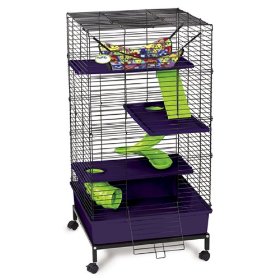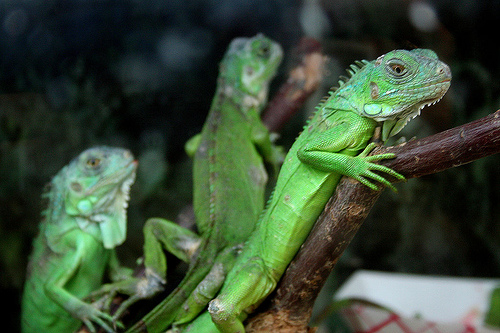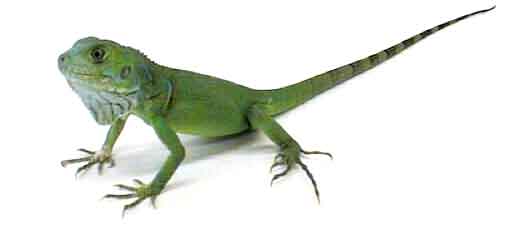I am almost 5 months pregnant and thinking of getting a pet iguana. I’ve owned one in the past and love them!! I realize the risk of salmonella, so I know to keep my hands clean and let the hubby tend to the cage cleaning. As long as I am cautious, would it be safe to own one?
Author:
Build Iguana Cage – Tips and tricks in building an iguana cage
Iguanas are arboreal, they prefer to stay in a large and wide ecosystem. Iguanas also tend to spend its time high up in tall trees. It is because their enemies or predators will not be able to follow them up in high trees. Most iguanas can easily hide from their enemies, by climbing jumping down into the ground without getting hurt.
But today, the lives of iguanas are in danger. Some of them are being caught and eaten by wild animals.
If you’re an animal or pet lover you can help these iguanas to survive against predators and help them from being extinct. You can do this by taking care of iguana, by just having at least pair.
Handling of iguanas needs proper planning. There are some things to be considered.
The first and most important thing is building a cage or enclosure. You must provide them with a good place where they can roam while having the freedom they enjoy in the wild.
Here are some more tips in building a great home for your iguana.
1. Look for a cage that is spacious and secured. A large room or a big closet can be a good place where they can roam. You can add artificial plants and branches where they can climb and hang over. If your iguana is still young, be sure to make the appropriate size of the cage. A smaller one with no hole is recommended so that they’ll not escape from the cage. When your iguana grows and get habituated to his new home, you can expand the area so that it will not look crowded.
2. Another thing to consider in building an iguana cage is the air circulation. Look for a cheap but comfy closet with proper air circulation. You can put a small, low-cost and quiet fan that will help regulate the air and raise the temperature and humidity inside the cage. A closet which has a good flow of air can also prevent the growth of mildew. But in case a mildew problem occurs, you can simply wash the walls using water and bleach.

3. During the night time, you can use a heating pad to warmth your iguana. Look for a light bulb that consumes less electricity. You can simply screw a 75 watt bulb on the wall of the cage.
4. Let your iguana adapt first to the new enclosure. Iguanas might get traumatized or hurt themselves if placed in a new environment. Iguanas normally react if placed in a new enclosure by rubbing and scratching the walls. It is advisable that you stay with your iguana as they explore. Try to bond with your pet until he gets acquainted with his new environment.
5. Be cautious on the electrical connections positioned on the enclosure. All wiring must be carefully situated in areas where your iguana can’t reach them. Iguanas are intrusive creatures, they will try to jump and climb up on accessible wirings and hot light equipments.
6. Lastly, keep your enclosure away from pests. Remove left over foods as soon as possible. Remember that cleanliness is the most essential factor to prevent possible problems.
Building a cage for your iguana can be simple and fun. Just follow the steps above and surely you’ll have a perfect enclosure for your pet.
I’m thinking about getting an iguana, but I have other pets …?
I also have indoor cats and dogs (cats are not declawed and I have two Golden Retrievers). Is this a good idea or am I inviting trouble? Anyone with experience with this, please advise.
Baby Iguanas – Babying your Baby Iguana the Right way
If there are baby dogs, cats or rabbits, then there are also baby iguanas. It is during this stage that these iguanas appear in their most fragile and need your loving care the most. Although they appear like they are easy to take of in their small appearance, proper precaution is needed so that they will be healthy in their older years.
Just like any juvenile pet, there are certain requirements that you need to provide for your baby iguana. Although they are not as meticulous and as herd to get as any other pet food, you should also consider if these things will be perfect for your iguana. You do not want them to become sickly and eventually die even before you see them in their full sizes, now do you?
Here are some of the important factors you need to consider when taking care of your baby iguana.
1. Shelter.
Not just any other type of cage will do. Though it does not matter what kind it is made of, you need to consider what should be inside the cage that the iguana will need.
An example is having something in them that will keep your pet warm during the night. Check out for carpeting or artificial turf to cover the flooring area of the cage. If you do not have the budget for it, you can opt for newspapers because they work just as well.
Since iguanas live on trees, you need to set up some branches for your pet to climb on to. Climbing on branches will form part of their leisure and movements. Just make sure that the branches are stable enough to hold their weight in case they lay down on them.

2. Temperature.
Baby iguanas should always be warm in order to stay healthy. Since you have no way of telling this just by looking at them, you can put a thermometer inside their cage so you can monitor the changes in the temperature inside the cage.
Make certain that you maintain a temperature of 70 degrees during the night and 85 degrees in the day. It is also a good idea for the cage for its shelter to be placed near a source of heat. You will see that your pet is inclined to have a comfortable rest if they stay close to that heat being radiated.
Special monitoring of temperature is required during the cold season. Check the shelter regularly. You would not want your pet to freeze to death without you knowing.
3. Food intake.
Baby iguanas need to have a diet that is rich in Vitamin D3, phosphorous and calcium. Lots of greens are also needed. You can also give them vegetables and fruits that you yourself are consuming.
Baby iguanas are not used to being fed any kind of food. Their digestive system is not as strong and as flexible as cats or dogs. Know what kind of food they can take and what they cannot.
Your baby iguana can grow up healthy and strong just by taking care of them the way you do any kind of pet. If it is absolutely necessary, you can consult a vet that specializes in iguana for things that are far beyond your comprehension. They will be able to give you sound advices regarding your baby iguana and the things that you need to do.
Can my pet iguana stay outside in the rain?
He seems to like it although he can get into the shelter area of his cage. He is just sitting on his deck outside of his cage in the rain.
my pet iguana is growing a scab under his neck.what do i do?
my iguana has a piece of skin that has yellow and dark colors on its neck.some iguanas has this spot that hngs form it neck. thats where its growing the scab.what do i do?
where can i get a family safe pet iguana?
does anyone know where i can buy a pet (safe) iguana… i really want one.. and i already had one but it was a gift and i dont know where it came from lol .. but it ran away in my backyard, through a hole in the fence!…
How to litter box Train an iguana?
I’ve heard of it being done but I never knew how, I would really like a pet iguana and I want it to be litter box trained.
-Thank you
Does anyone know how fast they grow?
What kind of lizards (that are ideal as pets for a 10 year old) do not eat live food, besides an iguana?
Baby Green Iguana – Interesting Informations About The Baby Green Iguana
The green iguana is one kind of reptile which is commonly found all throughout South and Central America. The breeds of the green iguana are also spotted in Mexico, Paraguay, Brazil, and the Caribbean Islands. There is no definite proof that the green iguana ranks among the endangered animals but then it is sometimes misconstrued to be one because it is a major attraction to the hunters. Hunters love to capture the big female iguanas. The green iguana is also a favorite delicacy of some and it is known by the name of “Bamboo Chicken”.
The Physical Appearance of the Green Iguana
The overly grown green iguanas typically grow in between four and six feet but there are some that extend up to seven feet. The tail takes up almost all of the length since it ranks to be almost half of the entire body measurement. Despite their being green, there is likewise the dominant black stripe coloring in its body. Not because they are called green iguanas they will already settle for the monochromatic color of green. The shade also diverts from the very bright green to the grayish and dull green. The skin of the green iguana is mostly rough primarily because of the pointy scales along the animal’s back. The green iguanas are equipped with claws and long fingers so that they can easily grasp and climb.
The Habitat of the Green Iguana
Baby green iguanas are typically raised in the tropical rainforest areas specifically in areas with lower altitudes and accessible water resources like those of the streams and rivers. Most of their formative years are confined in the forest top at about forty up to fifty feet high atop the ground.

The Admirable Adaptations of the Baby Green Iguanas
Aside from the invariable claws and long fingers possessed by the baby green iguanas, they also have a lot of proficient and admirable adaptations with them. The baby green iguanas are keen in terms of their senses of hearing, sight, and smell. One of their defense mechanisms is their tail which is obviously sharp and is snapped high into the air when danger is sensed. Once a predator gets the chance to grab the tail, it grows again without any damage at all. The skin of the baby green iguana is tough—it is able to avoid scratches, cuts, and is also water-resistant. The pigmentation on the skin of the baby green iguana helps out in the camouflaging especially when there are predators in the area. But then when their predators detect them, the baby green iguanas are able to swiftly jump from the trees and then dive directly into the water. Mind you, they are excellent swimmers.
Apart from these excellent adaptations, the baby green iguanas are also strong. Imagine that they do fall off the ground at about 40 up to 50 feet but they still manage to come unhurt. The male green iguanas have what is known as the dewlap on their skins. This is the special flap on their skins which they use to impress the female green iguanas or to intimidate their oncoming predators. With these dewlaps, they manage to let themselves appear bigger. Another excellent characteristic for the green iguanas is that they are able to keep fat under their own necks and jaws for quite a time especially when there is not much of the food at hand.
